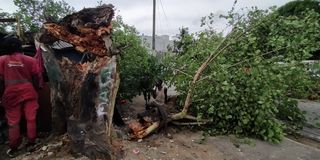
Volunteers help clear the road in the Mbaraki area of Mombasa County after strong winds brought down trees on Tuesday. No casualties were reported in the incident.
When the Kenya Meteorological Department (KMD) issued an alert over the weekend, about an impending storm in the Indian Ocean which would affect coastal counties, the main focus by disaster management teams was on how to prevent disasters in the sea.
In its alert, the KMD warned that the region would witness heavy rainfall, strong winds and large ocean waves.
Several notices were quickly sent out to maritime operators, mostly fishermen who rely on small boats, to avoid the sea during the period Tropical Storm Ialy was expected to last within Kenyan waters.
However, by Monday night, there were clear signs in Mombasa, Kilifi and Kwale counties that incidents might occur on the mainland, due to strong winds.
In a significant turn of events, the KMD revealed on Tuesday that Tropical Storm Ialy had, in fact, escalated into a cyclone moving too close to Kenya, marking a historic moment in the South-West Indian Ocean Basin.
In science, what differentiates a storm from a cyclone are factors such as its speed, size and mode of movement.
The World Meteorological Organisation states that, "a tropical cyclone is a rapidly rotating storm originating over tropical oceans from where it draws the energy to develop".
"It has a low-pressure centre and clouds spiraling towards the eye-wall surrounding the 'eye', the central part of the system where the weather is normally calm and free of clouds," it adds.
The diameter of a cyclone varies from around 200km to 1,000km.
According to the National Aeronautics and Space Administration (Nasa), tropical cyclones bear different names depending on where they occur.
The term tropical cyclone is often used in the Indian Ocean, while hurricanes are for the Atlantic and East Pacific, and typhoons are in the West Pacific.
Hurricane and typhoon
"The terms 'hurricane' and 'typhoon' are regional names for tropical cyclones. All tropical cyclones are alike in that they draw heat from warm water at the ocean's surface to power horizontal, rotating wind," the agency states.
In this week's occurrence at the coastal region, not only did the storm escalate into a cyclone but the eventual cyclone came too close to Kenya's coastline in a manner that meteorological experts say was unprecedented.
This is because ordinarily, the physics surrounding cyclone formation are not applicable within 480km from the equator. This is the reason why the previous Cyclone Hidaya had little effect on Kenya as compared to neighbouring Tanzania.
However, Cyclone Ialy passed within 150km of the Kenyan Coast, a very rare occurrence, leaving behind a trail of destruction and loss of two lives in the coastal region, among them a four-year-old kindergarten pupil.
“This development, unprecedented in the era of satellite observation, finds the intense system positioned northwest of 5 degrees S/45 degrees E, alarmingly close to the Kenyan Coast," stated the Meteorological Services Director Dr David Gikungu in a statement.
"Cyclone Ialy was peculiar in that it moved fairly close to the equator and retaining significant force, characterised by strong winds (55 km/hr) and high ocean waves and gusts at maximum speeds of 75km/hr," Dr Gikungu further explained.
While cyclones are rare near the Equator due to the weak Coriolis Effect, Cyclone Ialy's occurrence highlights the possibility of storms impacting equatorial regions in future.
This underscores the importance of continuous monitoring and understanding of atmospheric dynamics in the South-West Indian Ocean.
In conclusion, the intensification of Tropical Storm Ialy into a cyclone serves as a reminder of the need for heightened awareness and preparedness for such weather phenomena, even in regions where they are traditionally less common.
As climate patterns evolve, events like Cyclone Ialy underscore the dynamic nature of our planet's weather systems and the importance of staying vigilant.








